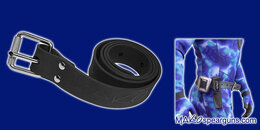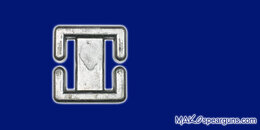Scuba Divers and Weight Belts:
Its been our observation that most experienced freedivers use rubber weight belts and most scuba divers don't. Why? Were really not sure, maybe some others have an idea?
Rubber belts provide some significant advantages over a typical nylon belt for both scuba divers and freedivers. The biggest problem/complaint with a standard belt is that it slides around. How many times have we seen scuba divers climb the ladder with their belt (often a soft, lead shot one) spun 180 degrees with the buckle hidden under their tank. Heaven help them if they should have to drop it when in that location.
Wetsuits compress with depth and this causes the nylon belt to become loose and often requires tightening at depth. A loose or sliding weight belt is much more likely to fall off. Who wants to be messing with a buckle when you should be scanning for fish as you drop down on a wreck or reef? Scuba divers often resort to over tightening the belt before the descent, which makes the belt uncomfortable and also makes the buckle prone to popping open becaue there is too much stress on the buckle. Heaven help you if you are trying to do this with a plastic buckle!
A rubber belt provides automatic depth compensation abilities due to its elasticity, but there are other more subtle advantages as well. The rubber belt is more tacky than a nylon belt and tends to stick to a wetsuit and is much less likely to slide or spin; the belt will pretty much stay where you put it. This allows the weight belt to be worn in a variety of positions.
People with low back problems are familiar with the ache and fatigue of wearing a relatively heavy belt over the small of their back. A rubber belt can be worn much lower (over the buttocks) for example, and it will not slide off as a nylon belt would. Getting the pressure off the lumbar area (low back) can greatly improve comfort. Freedivers often like to wear their belts as low as possible so that it does not constrain their breath up and this may benefit scuba divers as well.
We feel that the popularity of weight integrated BCs is partly due to the fact that the typical nylon belts are really not the optimal solution. Weight integrated BCs present a few unique problems in that they make the scuba unit heavier to handle and placing all your ballast on the BC can make removal of a scuba unit underwater a challenge, since the diver might find himself floating up without any ballast. Granted, these issues are minor when only a small amount of lead is required with a thin suit, but many instructors recommend that if a scuba diver needs more than about 12 lbs of lead, distributing some lead on a weight belt (rather than exclusivelt within the BC) may be beneficial.
Take a look at our rubber belt. It looks old or archaic with the simple stainless steel buckle. It looks like it is not as easily ditched as a typical nylon belt. The opposite is probably true. The belt is assembled in a unique way that applies compression of the rubber from the metal pin when the buckle is in the closed position. To release the belt, requires only one hand; the free end of the belt is grabbed, pulled and then released. The buckle automatically pops open and the elasticity of the belt assists in a very quick and simple release. The belt seems to pop off your waist. It is a little hard to describe, but once you try it for yourself, the functionality of this timeless design becomes quite evident.
This type of buckle is NOT prone to popping open or catching on things at inopportune times as typical nylon belt buckles sometimes do. We know very few scuba divers who, once they try a rubber weight belt, will go back to their old ways.
Regardless of whether you free or scuba dive, you owe it to yourself to try out a rubber belt. It is an inexpensive item that has the potential to improve your comfort and possibly your safety.
Can you tell we get excited about dive gear? MAKO would like to get more divers to try the rubber belt, especially scuba divers who might not be familiar with them.
Our normal price for the weight belt is $24.99 (which is a probably impossible to beat anywhere else). However, for the next 7 days (until 5:00 p.m. Wednesday January 13), we will be discounting the belt to only $19.99 (a 20% savings).
MAKO Spearguns - Freedive Weight Belt
The website has not been updated with this discount, so you will have to make the order via telephone:
(540) 361-1570.
Dive Safe!
MAKO
Its been our observation that most experienced freedivers use rubber weight belts and most scuba divers don't. Why? Were really not sure, maybe some others have an idea?
Rubber belts provide some significant advantages over a typical nylon belt for both scuba divers and freedivers. The biggest problem/complaint with a standard belt is that it slides around. How many times have we seen scuba divers climb the ladder with their belt (often a soft, lead shot one) spun 180 degrees with the buckle hidden under their tank. Heaven help them if they should have to drop it when in that location.
Wetsuits compress with depth and this causes the nylon belt to become loose and often requires tightening at depth. A loose or sliding weight belt is much more likely to fall off. Who wants to be messing with a buckle when you should be scanning for fish as you drop down on a wreck or reef? Scuba divers often resort to over tightening the belt before the descent, which makes the belt uncomfortable and also makes the buckle prone to popping open becaue there is too much stress on the buckle. Heaven help you if you are trying to do this with a plastic buckle!
A rubber belt provides automatic depth compensation abilities due to its elasticity, but there are other more subtle advantages as well. The rubber belt is more tacky than a nylon belt and tends to stick to a wetsuit and is much less likely to slide or spin; the belt will pretty much stay where you put it. This allows the weight belt to be worn in a variety of positions.
People with low back problems are familiar with the ache and fatigue of wearing a relatively heavy belt over the small of their back. A rubber belt can be worn much lower (over the buttocks) for example, and it will not slide off as a nylon belt would. Getting the pressure off the lumbar area (low back) can greatly improve comfort. Freedivers often like to wear their belts as low as possible so that it does not constrain their breath up and this may benefit scuba divers as well.
We feel that the popularity of weight integrated BCs is partly due to the fact that the typical nylon belts are really not the optimal solution. Weight integrated BCs present a few unique problems in that they make the scuba unit heavier to handle and placing all your ballast on the BC can make removal of a scuba unit underwater a challenge, since the diver might find himself floating up without any ballast. Granted, these issues are minor when only a small amount of lead is required with a thin suit, but many instructors recommend that if a scuba diver needs more than about 12 lbs of lead, distributing some lead on a weight belt (rather than exclusivelt within the BC) may be beneficial.
Take a look at our rubber belt. It looks old or archaic with the simple stainless steel buckle. It looks like it is not as easily ditched as a typical nylon belt. The opposite is probably true. The belt is assembled in a unique way that applies compression of the rubber from the metal pin when the buckle is in the closed position. To release the belt, requires only one hand; the free end of the belt is grabbed, pulled and then released. The buckle automatically pops open and the elasticity of the belt assists in a very quick and simple release. The belt seems to pop off your waist. It is a little hard to describe, but once you try it for yourself, the functionality of this timeless design becomes quite evident.
This type of buckle is NOT prone to popping open or catching on things at inopportune times as typical nylon belt buckles sometimes do. We know very few scuba divers who, once they try a rubber weight belt, will go back to their old ways.
Regardless of whether you free or scuba dive, you owe it to yourself to try out a rubber belt. It is an inexpensive item that has the potential to improve your comfort and possibly your safety.
Can you tell we get excited about dive gear? MAKO would like to get more divers to try the rubber belt, especially scuba divers who might not be familiar with them.
Our normal price for the weight belt is $24.99 (which is a probably impossible to beat anywhere else). However, for the next 7 days (until 5:00 p.m. Wednesday January 13), we will be discounting the belt to only $19.99 (a 20% savings).
MAKO Spearguns - Freedive Weight Belt
The website has not been updated with this discount, so you will have to make the order via telephone:
(540) 361-1570.
Dive Safe!
MAKO






